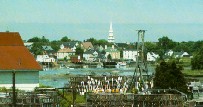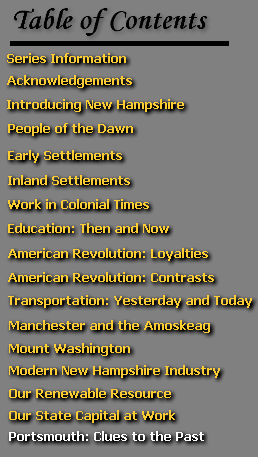|
SUMMARY
 Everywhere
in the present, there are always signs of the past. Nowhere is that truer
in Our New Hampshire than in the city of Portsmouth. Everywhere
in the present, there are always signs of the past. Nowhere is that truer
in Our New Hampshire than in the city of Portsmouth.
This lesson uses photography,
archaeological information, photos of the past, old prints, paintings and
music to capture those signs and trace that history. Students are asked
to look for clues to the past as the lesson shows street signs, an archaeological
dig, fishing scenes, colonial homes, old forts and old pilings. As clues
to past lifestyles, the lesson looks at architectural designs of the Jackson
House, Macphaedris-Warner House, John Paul Jones House, Langdon House,
Rockingham Hotel and Wentworth-By-the-Sea.
Portsmouth began in the 1600s
as a small settlement in which fish and lumber were the chief source of
the colonists' income. It grew from a tiny community, barely surviving
colonial hardships, into a busy young seaport, getting rich on trade with
the Indies, England and Europe. This booming 1700s ocean trade created
a demand for more ships, and shipyards along the Piscataqua River were
kept very busy.
Fires, war and population
growth of the early 1800s began to turn the prosperity of Portsmouth around.
Raw materials such as fish, lumber and furs--the chief sources of Portsmouth's
early wealth--began to disappear. The city found itself off the mainstream
of railroad traffic, and the Industrial Revolution turned the focus to
the textile centers of New Hampshire.
The port city regained some
of its importance in New England when the 1849 gold rush in California
produced a need for sleek clipper ships to carry supplies out West. This
gold rush boom was replaced some 11 years later by a demand for fiqhting
ships to fight the Civil War.
During these late 1800s,
Portsmouth produced a businessman and politician named Frank Jones. In
the spirit of great men like Andrew Carnegie and Henry Ford, Jones undertook
a variety of business ventures which brought many-faceted prosperity to
the city. Through the efforts of Frank Jones, Portsmouth in the late 1800s
was no longer a one-industry town.
The story of Portsmouth in
the l900s is shaped largely by the Portsmouth Naval Shipyard and its contribution
to two World Wars. The city's population experienced another growth spurt
when, in 1957, Pease Air Force Base was built in neighboring Newington.
Growth, expansion of needs
and modernization began to take a toll on the Portsmouth of the past, and
the treasures and proud history of the old town by the sea were being bulldozed
away.
In 1960, a group of concerned
citizens worked hard to save Strawbery Banke, a piece of Portsmouth's past.
Through their efforts the Banke has become a place where students of history,
architecture and fine arts come to learn about America's past. The Strawbery
Banke activity has made Portsmouth aware of the importance of its historical
treasures, and has helped visitors and residents see Portsmouth as an "old
town by the sea," were the past and present walk hand-in-hand.
OBJECTIVES
1. To help students
understand the relationship of past history to the present.
2. To foster an interest
and excitement in discovering history by making students more aware of
the visual clues to the past that are all around them.
3. To familiarize
students with the important role which Portsmouth played in New Hampshire
history.
4. To help students
understand the continual ebb and flow of a town's social, economic and
political makeup and importance.
5. To help students
appreciate the importance of preserving our heritage as we build our future.
PRE-VIEWING ACTIVITIES
1. Discuss with students
their present knowledge of the city of Portsmouth (or of their own community's
history).
2. Introduce the new
vocabulary listed under Words to Know.
3. Discuss with students
what clues they might look for in a modern town that would give them some
hints about the town's past.
4. Have students debate
the issue: It is important to preserve a town's past while building the
future.
5. Have students locate
Portsmouth on a map of New Hampshire, discuss its location, and brainstorm
some of the industries in which the town may have engaged in the past.
6. A modern community
is very different from a community of the past. Discuss some of those differences
and how those differences might affect how a town looks.
7. Have each student
choose a partner and observe that partner very carefully. Next have one
partner secretly change three things on them and have the other member
see if s/he can discover what is different. Reverse the task. Tell students
this activity is designed to increase their powers of observation so that
in this lesson they can look for clues about the history of Portsmouth.
POST-VIEWING ACTIVITIES
1. Discuss the following:
How was Portsmouth different
from other New Hampshire towns in the early 1700s?
What contributed to Portsmouth's
wealth?
What were some of the reasons
for the decline of Portsmouth's prosperity in the early 1800s?
What are some of the visual
clues left in Portsmouth today that give us a hint to its past?
How did inland settlements
affect the prosperity of Portsmouth in the early 1700s? early 1800S?
What happened in 1849 that
brought new life to the old town of Portsmouth.
What role did Portsmouth
shipbuilders play in the Civil War?
What effect did the Industrial
Revolution have on the city of Portsmouth?
How was modern city life
beginning to effect the remnants of Portsmouth history?
2. Do a class report
on one of the following:
Investigate some of the
merchants, politicians, and shipbuilders important to Portsmouth history.
Be sure to know their contributions.
Discover what the following
houses tell us about Portsmouth's past:
Jackson House
Macphaedris-Warner House
John Paul Jones House
Langdon House
Research the history of your
town: i.e., how people lived, earned a living, who was important in the
town.
Learn about the fishing
industry and lobstering in coastal New England towns like Portsmouth.
Investigate shipbuilding
in New England.
Trace the history of the
Portsmouth Naval Shipyard or Pease Air Force Base to the present time.
Study some of Portsmouth's
architecture and some of the structures which tell its history (widow's
walk, casement windows, sloping roofs, spiral staircases, pitched gables,
narrow brick chimneys, fireplaces). Design your own home using the structural
details you find appealing.
Compare the seaport life
of Portsmouth with another New England port such as New Bedford, Mass.,
Mystic Seaport, Conn.
3. Do one of the following:
Make a model of a gundalow,
Clipper Ship (like the Typhoon, Nightingale, or Witch of the Water), battleship
(like the Kearsarge, U.S.S. Ranger), or submarine. Be sure to know their
purpose.
Begin a collection of photographs,
prints or sketches of fire-fighting equipment from past to present (fire
destroyed many small towns).
Begin a collection of photographs,
prints or sketches of ships similar to those sailing to and from Portsmouth.
Create a diorama of an old
fort similar to Ft. McClary or Ft. Constitution. Be sure to know their
purpose.
4. Interview some of
the older people of your town and have them describe what life was like
in your town's past. Record what they say on paper or audiotape.
5. Keep a log in which
you jot down:
Some of the street signs
in your town which give you some idea of what may have happened there or
who may have been famous there in the past.
Some of the remnants of
the past left in your town (i.e., old hitching post, gasoline pump).
Some of the oldest buildings
in your town, their beginnings and purpose.
6. Dramatize one of the
following:
After investigating who
is responsible for Strawbery Banke and why it is important to New Hampshire,
decide in small groups what is important for you to preserve in your town,
what repairs need to be done, how to protect those landmarks for future
generations.
After researching "privateering,"
re-enact what it might have been like in a high seas raid.
After investigating some
of the main points of an archaeological "dig," act out what it might be
like if people thousands of years from now were to discover our garbage
and remains. What would those discovered items tell them about our civilization?
7. Find out where in
your town people used to deposit their "throw-aways." With any necessary
permission granted, go on a "bottle dig" to discover life in the past.
(Cellar holes are generally a good place to begin. Items were thrown away
from the house toward the back of the house, often over a small knoll.)
VOCABULARY
-
gundalow
-
merchant
-
mansion
-
privateering
-
fortifications
-
shipwright
-
clipper ships
-
architecture
-
water wagons
-
cargo
-
wharves
-
prospectors
-
brewery
-
preservation
PLACES TO VISIT
PEOPLE TO KNOW
ORGANIZATIONS TO CONTACT
WEB RESOURCES
|




